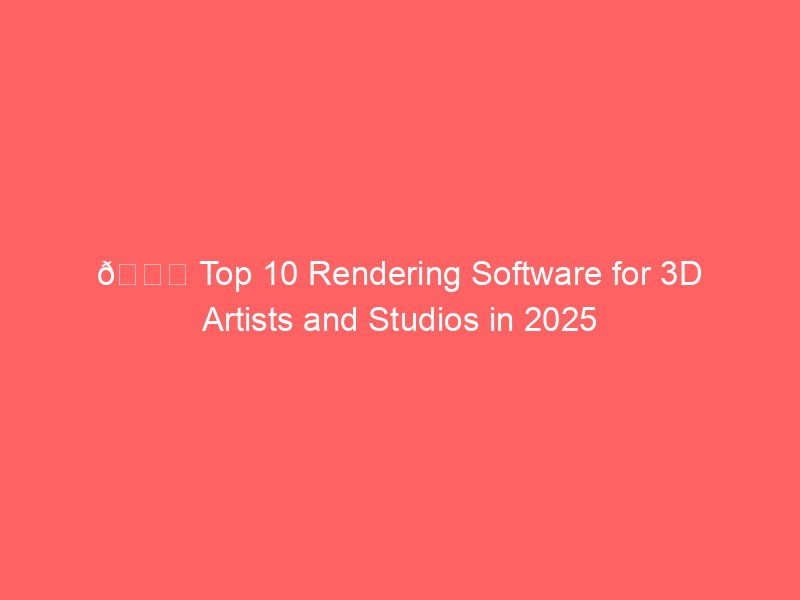When you watch a blockbuster movie filled with explosions, futuristic cities, or magical creatures, most of that magic is made possible through compositing software. Compositing is the process of combining multiple visual elements (live-action footage, CGI, matte paintings, particle effects, etc.) into a single seamless image.
From Hollywood studios to YouTube creators, compositing software is an essential tool for storytelling. Let’s explore the 10 best compositing software tools in 2025, along with their strengths, drawbacks, and best uses.
1. Adobe After Effects
Probably the most well-known compositing and motion graphics tool, After Effects is widely used in film, advertising, and content creation.
- Best for: Motion graphics, VFX for video creators, advertising.
- Key Features:
- Node-like pre-compositions for organizing effects.
- Huge plugin ecosystem (Red Giant, Video Copilot, etc.).
- Motion graphics templates for Premiere Pro.
- Node-like pre-compositions for organizing effects.
- Pros: Industry staple, versatile, integrates with Adobe Creative Cloud.
- Cons: Can be slow with very large projects, subscription-only pricing.
2. Nuke (The Foundry)
When it comes to high-end compositing for Hollywood blockbusters, Nuke is the go-to tool.
- Best for: Film studios and professional VFX pipelines.
- Key Features:
- True node-based compositing for maximum flexibility.
- Deep compositing (handles 3D depth data for realistic layering).
- Built-in 3D environment for projections and tracking.
- True node-based compositing for maximum flexibility.
- Pros: Extremely powerful, standard in the film industry.
- Cons: Expensive, steep learning curve.
3. Blackmagic Fusion
Now integrated into DaVinci Resolve, Fusion is a node-based compositing software that competes directly with Nuke.
- Best for: Indie filmmakers and studios using DaVinci Resolve.
- Key Features:
- Node-based workflow.
- Advanced keying, rotoscoping, and 3D compositing tools.
- GPU acceleration for faster performance.
- Node-based workflow.
- Pros: Affordable (even free via Resolve), professional-grade.
- Cons: Smaller plugin ecosystem compared to After Effects.
4. Natron
An open-source compositing software, Natron provides professional-grade features for free.
- Best for: Students, freelancers, and indie creators on a budget.
- Key Features:
- Node-based system like Nuke and Fusion.
- OFX plugin compatibility.
- Keying, rotoscoping, and tracking tools.
- Node-based system like Nuke and Fusion.
- Pros: Free, open-source, lightweight.
- Cons: Less polished UI, slower development updates.
5. HitFilm Pro (FXhome)
A hybrid software that combines editing, VFX, and compositing, HitFilm Pro is popular among YouTubers and indie filmmakers.
- Best for: Content creators who want editing + VFX in one.
- Key Features:
- Built-in effects library (explosions, muzzle flashes, energy beams).
- Timeline-based compositing.
- 3D model import.
- Built-in effects library (explosions, muzzle flashes, energy beams).
- Pros: Beginner-friendly, affordable, great for social media creators.
- Cons: Not as powerful as Nuke or Fusion for complex film VFX.
6. Apple Motion
Apple’s lightweight alternative to After Effects, Motion is designed for Mac users who need motion graphics and compositing tools.
- Best for: FCPX (Final Cut Pro) users.
- Key Features:
- Real-time design previews.
- Particle emitter and replicator effects.
- Direct integration with Final Cut Pro.
- Real-time design previews.
- Pros: Affordable, optimized for Mac performance.
- Cons: macOS only, limited compared to After Effects.
7. Autodesk Flame
A high-end finishing and compositing software, Flame is widely used in advertising and big-budget production houses.
- Best for: Broadcast, commercial post-production, advanced finishing.
- Key Features:
- Node-based compositing with timeline integration.
- AI-powered machine learning tools (image isolation, cleanup).
- Advanced color grading and look development.
- Node-based compositing with timeline integration.
- Pros: Extremely powerful, used in commercials and high-end VFX.
- Cons: Expensive, hardware-intensive.
8. Cavalry
A relatively new entrant, Cavalry is more of a motion design and 2D compositing tool, aiming to disrupt After Effects.
- Best for: Motion designers seeking a modern tool.
- Key Features:
- Procedural animation tools.
- Real-time playback.
- Smart rigging for complex motion graphics.
- Procedural animation tools.
- Pros: Faster than After Effects for certain workflows.
- Cons: Still growing, smaller ecosystem.
9. Smoke (Autodesk)
Although not as popular today, Smoke combines editing, VFX, and compositing in one application, primarily used in broadcast editing.
- Best for: Editors who need built-in VFX and compositing.
- Key Features:
- Node-based compositing.
- Integrated editorial timeline.
- Finishing tools.
- Node-based compositing.
- Pros: Integrated post-production solution.
- Cons: Less common today, overshadowed by Flame and Fusion.
10. SilhouetteFX (Boris FX)
Focused mainly on rotoscoping and advanced paint tools, SilhouetteFX is an excellent specialized compositing tool.
- Best for: Roto, keying, cleanup, and prep work in VFX pipelines.
- Key Features:
- Advanced spline-based rotoscoping.
- Non-destructive paint tools.
- Stereo 3D support.
- Advanced spline-based rotoscoping.
- Pros: Industry-leading roto & paint.
- Cons: Not a full compositor like Nuke or Fusion.
🔑 Final Thoughts
- For professionals in Hollywood studios: Nuke and Flame remain industry leaders.
- For indie filmmakers and freelancers: Blackmagic Fusion (via DaVinci Resolve) and Natron offer incredible value.
- For content creators and YouTubers: After Effects, HitFilm Pro, and Apple Motion are better choices.
- For specialized roto/paint work: SilhouetteFX is unmatched.
Choosing the right software depends on your budget, pipeline, and creative needs. Big studios need high-end node-based tools, while small creators can get powerful results from affordable (or even free) solutions.





